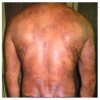An overview of cutaneous T cell lymphomas
- PMID: 27540476
- PMCID: PMC4965697
- DOI: 10.12688/f1000research.8829.1
An overview of cutaneous T cell lymphomas
Abstract
Cutaneous T cell lymphomas (CTCLs) are a heterogeneous group of extranodal non-Hodgkin's lymphomas that are characterized by a cutaneous infiltration of malignant monoclonal T lymphocytes. They typically afflict adults with a median age of 55 to 60 years, and the annual incidence is about 0.5 per 100,000. Mycosis fungoides, Sézary syndrome, and primary cutaneous peripheral T cell lymphomas not otherwise specified are the most important subtypes of CTCL. CTCL is a complicated concept in terms of etiopathogenesis, diagnosis, therapy, and prognosis. Herein, we summarize advances which have been achieved in these fields.
Keywords: Sézary syndrome; cutaneous T cell lymphoma; mycosis fungoides.
Conflict of interest statement
No competing interests were disclosed.
Figures



References
-
- Rodd AL, Ververis K, Karagiannis TC: Current and Emerging Therapeutics for Cutaneous T-Cell Lymphoma: Histone Deacetylase Inhibitors. Lymphoma. 2012;2012:1–10, 290685. 10.1155/2012/290685 - DOI
Publication types
LinkOut - more resources
Full Text Sources
Other Literature Sources

